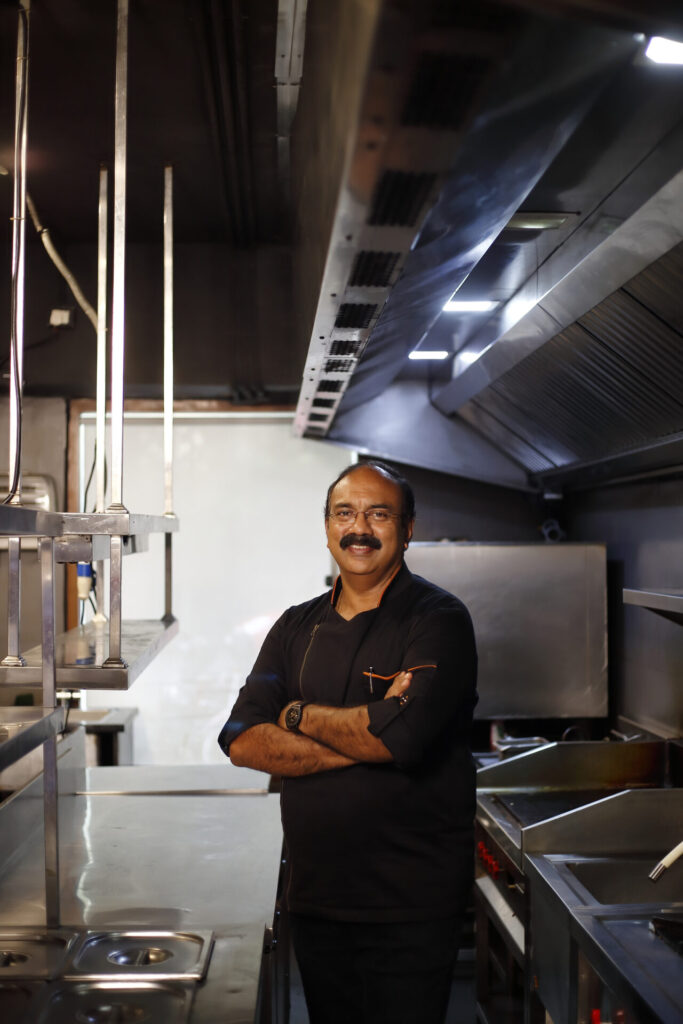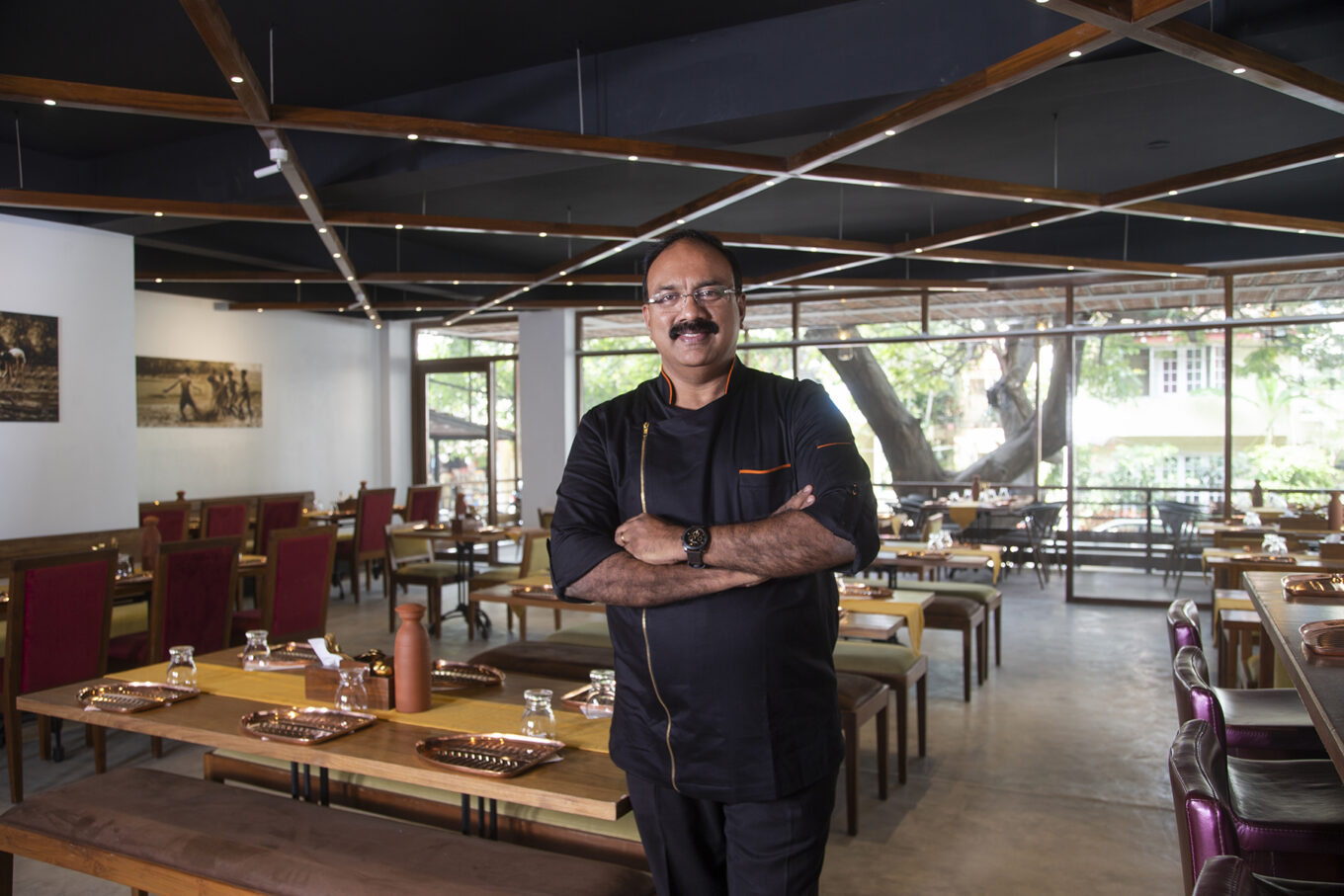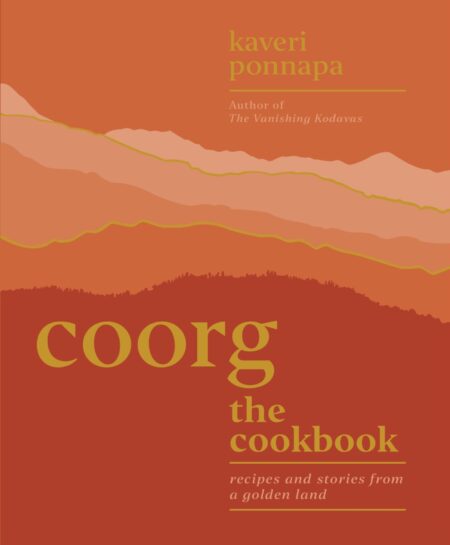Meet the Chef: Regi Mathew
The warm aromas of spices and coconut entice your senses the moment you walk into Kappa Chakka Kandhari. The tables are packed with multigenerational families, engrossed in the platters of food set out on their tables which might include star dishes such as kallummekka (roast mussels with shallots and spices from North Malabar), the superb prawn kizhi (steamed banana leaf pouches with coconut and kodampuli), a spicy, aromatic, kappa fish curry (fish curry and boiled, mashed tapioca) and the unfamiliar, flavour-intense pazham nanachathu, made from sun-dried bananas.The open kitchen, from where the aromas waft towards you has several ammachis, home-cooks, the women who inspired this unique restaurant, working on a selection of specialized dishes that feature on the menu. Many dishes are hyperlocal, rarely found outside individual homes or a specific region.

Named after the three essentials of a Kerala kitchen —tapioca, jackfruit and bird’s eye chillies— the award-winning Kappa Chakka Kandhari was co-founded by Chef Regi Mathew as a tribute to the home-cooking of Kerala. A chemistry graduate who chose the world of hotel management, Mathew found his metier in the kitchen, and joined the Taj Group as a trainee at Paradise Island, Taj West End in 1993. After decades of working with Thai cuisine, Mathew decided to turn his attention to the traditional cuisine of his home state, Kerala. Regi Mathew was named #1 Chef in Food Superstars 2023, by Culinary Culture, co-founded by food critic Vir Sanghvi.
KP —Kappa Chakka Khandhari is not a typical Indian restaurant. In fact, it does not fit any category easily. What were the ideas that went into its creation?
RM— My philosophy was simple. I wanted to recreate the slow-cooked home food of Kerala, the food cooked by women every day, with great thought and care. After more than 27 years as a chef in the hospitality industry, specializing in Thai food, and opening almost 90 restaurants, I decided I wanted to do something for the cuisine I grew up eating. The idea of KCK took shape in 2015 during a conversation I had with two friends. I am from Kottayam, and the other two, who are partners in KCK, from different parts of Kerala. While discussing food, we realised our memories were completely different. Kerala has varied and extensive cuisines across its different regions. So, we decided to explore and understand Kerala’s food in detail, and travelled across the state, a journey which lasted 3 years. We visited 265 homes and cooked with ammachis (mothers), learning about local dishes, rare techniques and uncommon ingredients. We also visited over 70 toddy shops, which are famous for their unique dishes, and collected many recipes. The number and range of recipes we collected is enormous: we now have over 800 documented dishes. We went about presenting some of these dishes by holding pop-ups in Chennai, Bengaluru and Dubai before opening the restaurant. This gave us an opportunity to gauge what appealed to people’s tastes, which helped select the dishes that would be presented in the restaurant.
KP—With such a vast repertoire of dishes, how did you narrow down choices for your menu?
RM— I did not want to limit the menu to a region-wise presentation, for instance ‘Malabar’ or ‘Alleppey’ and so on. Kerala has a vast and varied cuisine. I decided to make the menu a representation, more in the way of allowing the dishes to speak for themselves. Each of the unique dishes represents the women who cook them; they evoke memories of the absolute freshness of the food cooked and eaten in homes, and the fact that a good proportion of the ingredients were once home-grown. In addition, dishes such as koondal roast (dry roasted calamari rings), and kada dry roast (quail marinated in spices and pan roasted) are toddy shop style creations. Toddy shops rely on the uniqueness of the food they serve to attract customers. They all serve the same drink—toddy, so the food has to make each shop stand apart.
The food is always absolutely fresh, as these small places do not have refrigeration. They have about 8-10 dishes they make exceptionally well, and their customers are very discerning about what they eat. These are some of the special dishes on our menu. You will not find a malabar parotta or a biriyani here!
KP— How do you translate the flavours of these unusual dishes in a restaurant kitchen?
RM—Food has a process. There is a logic in cooking, a sequence. For instance, at most of the places we visited, the vessels were left partially uncovered during the cooking process. Spices are aromatic and the aromas would waft around, stimulating the appetite, and all the senses were engaged even before eating the dish. Similarly, there is a logic to the sequence in which ingredients are added to a dish. Like the ammachis, we stay with the basic principles and rules. There is no need to change them. If you want to innovate, play with the presentation.
We do not use pressure cookers. Everything is slow-cooked from scratch, in traditional vessels.
We also pay a lot of attention to the sourcing of ingredients, selecting ones from regions that produce the best. We identify areas where the soil and climate produce high-quality individual ingredients. For instance, tapioca grows in many parts of Kerala, but we source from Ramapuram, which produces superior quality. Coconuts, pepper, kandhari chillies—everything is sourced in a similar way. At KCK, we have two kitchens— the main kitchen, where we have professional cooks providing the structure, working beside home-cooks who are mainly women. I think they are the best cooks. The women bring their hand to special dishes, adding flavours that cannot be replicated by anyone else. The open, dispensing kitchen is where we finish and present dishes. It gives you a feeling of being in a home.
KP— The range of menu combinations is quite extensive and flexible. For instance, apart from the evocatively named set menus, such as ‘Toddy Shop Musings’ and ‘Ammachi Specials’, there are one pot meals such as Pidi Kozhi Curry, and guests can create their own set menu. How do you like to see people eat?
RM— Eating is a sensory, emotional experience. We have families come in that include a great-grandfather down to a 7-year old great-grandson. We sometimes find guests deeply moved by the food they eat, as the flavours are true, and evoke personal memories for them as they eat. The food should speak to them of the hands that cooked it with affection and care—the ammachis— just like it would be in a home. In terms of presentation, I like to see more protein on the plate, and present smaller portions of different dishes to stimulate the appetite. Eating with your fingers is a physical experience that also adds to the appreciation of a meal. I encourage eating with the fingers to appreciate the food.
KP—What are your personal favourites from this extensive menu?
RM—That’s a very difficult question to answer! No one dish is like the other. I love pidi and kozhi curry (rice dumplings with chicken curry), and our Cloud Pudding made from tender coconut and coconut milk is a signature dish. An exceptional —and difficult to cook— dish is avoli nellika masala (white pomfret in a masala of dried Indian gooseberries). If the berries are dried too young, you get a bitter flavour that ruins the dish. It’s difficult to gauge the right tartness and ripeness of the fruit. This is a dish from the Agasthyar tribal community near Trivandrum. Our kandhari ice cream is another favourite that took a long time to perfect. I used full fat milk, so that the fat coats the tongue, and the first taste is sweet and creamy. Once the ice cream reaches the back of the tongue, the fire from the bird’s eye chillies makes itself felt, opening up the most subtle blending of sweet and spice.
KP—KCK is always filled with people who obviously love the food. You currently have two branches, in two different cities. Do you have plans to expand the brand?
RM— KCK Chennai opened in 2018, and Bengaluru in 2019. There will be no more KCK. It is not possible. My respect for ammachis and the quality of the food keeps me from opening more branches. This is a tribute to my mother’s cooking and the food I grew up with. Many of the ammachis we learned from have visited KCK, and some of them work here—it is an ongoing relationship. Opening more branches would mean diluting this philosophy.
KP—There are so many cuisines a young chef can choose to specialize in today.
What would be your advice to an aspiring chef?
RM—I would say believe in your cuisine. Aim to learn about and present your own cuisine.
A lot of the dishes that are on the menu at KCK rely on spontaneity, rather than a specific recipe. But at the same time, some are family recipes that may disappear without documentation. A simple recipe from a Syrian Christian kitchen like pazham nanachathu is so delicious. The original made use of a glut of ripe bananas, avoiding waste. The excess fruits were sundried, and served with paani (palm jaggery) and grated coconut. This home-style dessert, a very popular one on the menu, is an example of how local dishes can be presented and appreciated. It’s a way of making sure they don’t get forgotten, and disappear. Regional cuisine deserves attention, it deserves its space.
This article appeared in Sommelier India Magazine. Autumn 2024




